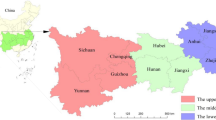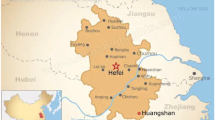Abstract
Agricultural eco-efficiency is a meaningful index that assesses agricultural sustainable development. Based on the super SBM-DEA approach incorporating agricultural carbon emissions and panel data regression, this study evaluates agricultural eco-efficiency and investigates the influencing factors in the agricultural production zone of Jilin Province. The empirical results show the following. (1) During the observation period, the average agricultural eco-efficiency exhibits a flat “M-shaped” fluctuating trend, a trend of fluctuant growth with phase characteristics, and the agricultural eco-efficiency of each county still has much room for improvement. (2) Significant spatial differences exist in agricultural eco-efficiency across counties. All of the studied counties, except for Nong’an, Huadian, Lishu, Yitong, Gongzhuling, and Qianguo, need to change their input and output structure to optimize agricultural eco-efficiency. (3) The panel data regression estimation results indicate that the agricultural technology extension level, multiple-crop index, agricultural economic development level, agricultural technology extension level, and urbanization level have close correlations with agricultural eco-efficiency. (4) The research findings have important implications for policy makers formulating agricultural environmental policies in accordance with the local conditions of various counties.





Similar content being viewed by others
Data availability
Some or all data, models, or codes that support the findings of this study are available from the corresponding author upon reasonable request.
References
Ali S, Gucheng L, Ying L, Ishaq M, Shah T (2019) The relationship between carbon dioxide emissions, economic growth and agricultural production in Pakistan: an autoregressive distributed lag analysis. Energies 12(24):4644
Angulo-Meza L, González-Araya M, Iriarte A, Rebolledo-Leiva R, de Mello JCS (2019) A multiobjective DEA model to assess the eco-efficiency of agricultural practices within the CF+ DEA method. Comput Electron Agric 161:151–161
Aparicio J, Ruiz JL, Sirvent I (2007) Closest targets and minimum distance to the Pareto-efficient frontier in DEA. J Prod Anal 28(3):209–218
Banker RD, Charnes A, Cooper WW (1984) Some models for estimating technical and scale inefficiencies in data envelopment analysis. Manag Sci 30(9):1078–1092
Baum R, Bieńkowski J (2020)Eco-efficiency in measuring the sustainable production of agricultural crops. Sustainability 12(4):1418
Burnett RD, Hansen DR (2008) Ecoefficiency: defining a role for environmental cost management. Acc Organ Soc 33(6):551–581
Camarero M, Castillo J, Picazo-Tadeo AJ, Tamarit C (2013)Eco-efficiency and convergence in OECD countries. Environ Resour Econ 55(1):87–106
Charnes A, Cooper WW, Rhodes E (1978) Measuring the efficiency of decision making units. Eur J Oper Res 2(6):429–444
Chen N, Xu L, Chen Z, Lund H, Kaiser MJ (2017) Environmental efficiency analysis of the Yangtze River Economic Zone using super efficiency data envelopment analysis (SEDEA) and Tobit models. Energy 134:659–671
Coluccia B, Valente D, Fusco G, De Leo F, Porrini D (2020) Assessing agricultural eco-efficiency in Italian regions. Ecol Indic 116:106483
Czyżewski B, Matuszczak A, Muntean A (2019) Approaching environmental sustainability of agriculture: environmental burden, eco-efficiency or eco-effectiveness. Agric Econ 65(7):299–306
Czyżewski B, Matuszczak GA, Guth M, Majchrzak A (2020) Environmental sustainable value in agriculture revisited: how does Common Agricultural Policy contribute to eco-efficiency? Sustain Sci 1-16:137–152
Deng X, Gibson J (2019) Improving eco-efficiency for the sustainable agricultural production: a case study in Shandong, China. Technol Forecast Soc Chang 144:394–400
Dubey A, Lal R (2009) Carbon footprint and sustainability of agricultural production systems in Punjab, India, and Ohio, USA. J Crop Improv 23(4):332–350
Fan J, Li P (2009) The scientific foundation of major function oriented zoning in China. J Geogr Sci 19(5):515–531
Fan J, Sun W, Zhou K, Chen D (2012) Major function oriented zone: new method of spatial regulation for reshaping regional development pattern in China. Chin Geogr Sci 22(2):196–209
Färe R, Grosskopf S, Lovell CK, Pasurka C (1989) Multilateral productivity comparisons when some outputs are undesirable: a nonparametric approach. Rev Econ Stat 71:90–98
Gkiza IG, Nastis SA (2017) Health and women’s role in agricultural production efficiency. Appl Econ Perspect Policy 39(3):428–440
Gössling S, Peeters P, Ceron JP, Dubois G, Patterson T, Richardson RB (2005) The eco-efficiency of tourism. Ecol Econ 54(4):417–434
Gómez-Limón JA, Picazo-Tadeo AJ, Reig-Martínez E (2012)Eco-efficiency assessment of olive farms in Andalusia. Land Use Policy 29(2):395–406
Grossman GM, Krueger AB (1995) Economic growth and the environment. Quart J Econ 110(2):353–377
Han H, Zhang X (2020a) Exploring environmental efficiency and total factor productivity of cultivated land use in China. Sci Total Environ:138434
Han H, Zhang X (2020b) Static and dynamic cultivated land use efficiency in China: a minimum distance to strong efficient frontier approach. J Clean Prod 246:119002
He J, Wan Y, Feng L, Ai J, Wang Y (2016) An integrated data envelopment analysis and emergy-based ecological footprint methodology in evaluating sustainable development, a case study of Jiangsu Province, China. Ecol Indic 70:23–34
Huang J, Xia J, Yu Y, Zhang N (2018) Composite eco-efficiency indicators for China based on data envelopment analysis. Ecol Indic 85:674–697
Huang X, Xu X, Wang Q, Zhang L, Gao X, Chen L (2019) Assessment of agricultural carbon emissions and their spatiotemporal changes in China, 1997–2016. Int J Environ Res Public Health 16(17):3105
Jin G, Li Z, Deng X, Yang J, Chen D, Li W (2019) An analysis of spatiotemporal patterns in Chinese agricultural productivity between 2004 and 2014. Ecol Indic 105:591–600
Li H, Fang K, Yang W, Wang D, Hong X (2013) Regional environmental efficiency evaluation in China: analysis based on the Super-SBM model with undesirable outputs. Math Comput Model 58(5-6):1018–1031
Liao J, Yu C, Feng Z, Zhao H, Wu K, Ma X (2021) Spatial differentiation characteristics and driving factors of agricultural eco-efficiency in Chinese provinces from the perspective of ecosystem services. J Clean Prod 288:125466
Lio MC, Hu JL (2009) Governance and agricultural production efficiency: a cross-country aggregate frontier analysis. Aust J Agric Econ 60(1):40–61
Liu Q, Wang S, Li B, Zhang W (2020a) Dynamics, differences, influencing factors of eco-efficiency in China: a spatiotemporal perspective analysis. J Environ Manag 264:110442
Liu J, Zhang J, Fu Z (2017) Tourism eco-efficiency of Chinese coastal cities–analysis based on the DEA-Tobit model. Ocean Coast Manag 148:164–170
Liu Y, Zou L, Wang Y (2020b)Spatial-temporal characteristics and influencing factors of agricultural eco-efficiency in China in recent 40 years. Land Use Policy 97:104794
Ma X, Wang C, Yu Y, Li Y, Dong B, Zhang X, Niu X, Yang Q, Chen R, Li Y, Gu Y (2018a) Ecological efficiency in China and its influencing factors—asuper-efficient SBM metafrontier-Malmquist-Tobit model study. Environ Sci Pollut Res 25(21):20880–20898
Ma X, Li Y, Zhang X, Wang C, Li Y, Dong B, Gu Y (2018b) Research on the ecological efficiency of the Yangtze River Delta region in China from the perspective of sustainable development of the economy-energy-environment(3E) system. Environ Sci Pollut Res 25(29):29192–29207
Maia R, Silva C, Costa E (2016)Eco-efficiency assessment in the agricultural sector: the Monte Novo irrigation perimeter. Portugal J Clean Prod 138:217–228
Moutinho V, Madaleno M, Macedo P (2020) The effect of urban air pollutants in Germany: eco-efficiency analysis through fractional regression models applied after DEA and SFA efficiency predictions. Sustain Cities Soc 59:102204
Peng H, Zhang J, Lu L, Tang G, Yan B, Xiao X, Han Y (2017)Eco-efficiency and its determinants at a tourism destination: a case study of Huangshan National Park, China. Tour Manag 60:201–211
Picazo-Tadeo AJ, Gómez-Limón JA, Reig-Martínez E (2011) Assessing farming eco-efficiency: a data envelopment analysis approach. J Environ Manag 92(4):1154–1164
Reith CC, Guidry MJ (2003)Eco-efficiency analysis of an agricultural research complex. J Environ Manag 68(3):219–229
Ren Y, Fang C, Lin X, Sun S, Li G, Fan B (2019) Evaluation of the eco-efficiency of four major urban agglomerations in coastal eastern China. J Geogr Sci 29(8):1315–1330
Saravia-Matus SL, Hörmann PA, Berdegué JA (2019) Environmental efficiency in the agricultural sector of Latin America and the Caribbean 1990–2015: are greenhouse gas emissions reducing while agricultural production is increasing? Ecol Indic 102:338–348
Schaltegger S, Sturm A (1990) Ökologische rationalität: Ansatzpunkte zur ausgestaltung von ökologieorientierten management instru-menten. Die Unternehmung 44(4):273–290
Schmidheiny S, Timberlake L (1992) Changing course: a global business perspective on development and the environment (Vol. 1). MIT press.
Sinkin C, Wright CJ, Burnett RD (2008)Eco-efficiency and firm value. J Account Public Policy 27(2):167–176
Tian Y, Zhang JB, He YY (2014) Research on spatial-temporal characteristics and driving factor of agricultural carbon emissions in China. J Integr Agric 13(6):1393–1403
Todorovic M, Mehmeti A, Scardigno A (2016)Eco-efficiency of agricultural water systems: methodological approach and assessment at meso-level scale. J Environ Manag 165:62–71
Tone K (2001) A slacks-based measure of efficiency in data envelopment analysis. Eur J Oper Res 130(3):498–509
Tone K (2002)Slacks-based measure of super-efficiency in data envelopment analysis. Eur J Oper Res 143(1):32–41
Vlontzos G, Niavis S, Manos B (2014) A DEA approach for estimating the agricultural energy and environmental efficiency of EU countries. Renew Sust Energ Rev 40:91–96
Wang Y, Fan J (2020)Multi-scale analysis of the spatial structure of China’s major function zoning. J Geogr Sci 30(2):197–211
West TO, Marland G (2002) A synthesis of carbon sequestration, carbon emissions, and net carbon flux in agriculture: comparing tillage practices in the United States. Agric Ecosyst Environ 91(1-3):217–232
Xing Z, Wang J, Zhang J (2018) Expansion of environmental impact assessment for eco-efficiency evaluation of China’s economic sectors: an economic input-output based frontier approach. Sci Total Environ 635:284–293
Yang L, Yang Y (2019) Evaluation of eco-efficiency in China from 1978 to 2016: based on a modified ecological footprint model. Sci Total Environ 662:581–590
Yin K, Wang R, An Q, Yao L, Liang J (2014) Using eco-efficiency as an indicator for sustainable urban development: a case study of Chinese provincial capital cities. Ecol Indic 36:665–671
Zeng L, Li X, Ruiz-Menjivar J (2020) The effect of crop diversity on agricultural eco-efficiency in China: a blessing or a curse? J Clean Prod 276:124243
Zhang B, Bi J, Fan Z, Yuan Z, Ge J (2008)Eco-efficiency analysis of industrial system in China: a data envelopment analysis approach. Ecol Econ 68(1-2):306–316
Zhou C, Shi C, Wang S, Zhang G (2018) Estimation of eco-efficiency and its influencing factors in Guangdong province based on Super-SBM and panel regression models. Ecol Indic 86:67–80
Zhou Y, Kong Y, Zhang T (2020) The spatial and temporal evolution of provincial eco-efficiency in China based on SBM modified three-stage data envelopment analysis. Environ Sci Pollut Res 27(8):8557–8569
Acknowledgements
The authors gratefully acknowledge all the reviewers and editors for their insightful comments.
Funding
The research received financial support from the National Natural Science Foundation of China (No. 41771138).
Author information
Authors and Affiliations
Contributions
Methodology, Guo Yanhua; software, Guo Yanhua; writing-original draft, Guo Yanhua; conceptualization, Tong Lianjun and Mei Lin; funding acquisition, Tong Lianjun; and writing-review and editing, Mei Lin.
Corresponding authors
Ethics declarations
Ethics approval
Not applicable.
Consent to participate
Not applicable.
Consent for publication
Not applicable.
Conflict of interest
The authors declare no competing interests.
Additional information
Responsible editor: Philippe Garrigues
Publisher’s note
Springer Nature remains neutral with regard to jurisdictional claims in published maps and institutional affiliations.
Rights and permissions
About this article
Cite this article
Guo, Y., Tong, L. & Mei, L. Spatiotemporal characteristics and influencing factors of agricultural eco-efficiency in Jilin agricultural production zone from a low carbon perspective. Environ Sci Pollut Res 29, 29854–29869 (2022). https://doi.org/10.1007/s11356-021-16463-0
Received:
Accepted:
Published:
Issue Date:
DOI: https://doi.org/10.1007/s11356-021-16463-0




